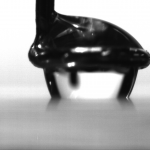Advances made in fabrication of patterned surfaces with well-defined dimensions of topographic features and their lateral dissemination drive the progress in interpretation of liquid spreading, adhesion and retreat on engineered solid surfaces. Despite extensive studies on liquid droplet spreading and adhesion on textured surfaces in recent years, conformation of the three-phase contact line and its effect on macroscopic contact angle and droplet adhesion remain in a focus of intensive debate. In our new paper entitled Contact Line and Adhesion Force of Droplets on Concentric Ring-Textured Hydrophobic Surfaces published in Langmuir, we investigate the effect of surface topography on adhesion force of Cassie-Baxter-state droplets on concentric ring-textured hydrophobic surfaces having rings with lateral dimensions of 5, 10, and 45 μm and separated by 5, 6, and 7 μm trenches, with fixed depth of 15 μm, respectively. Unlike mostly-tested surfaces textured with straight ridges, pores, and pillars, where the droplet base contact line is anisotropic and its conformation varies along the apparent boundary, concentric rings are symmetrical and reinforce the microscopic contact line to align to a circular one that reflects the shape of the pattern. In this study, adhesion forces were calculated based on surface tension and Laplace pressure forces and compared with the experimental forces for both water and ethylene glycol droplets having a varying contact diameter on the concentric ring-pattern at the point of maximum adhesion force. Results show that the microscopic contact line of the liquid retains its circular shape controlled by circular rings of the pattern, irrespectively of the droplet base diameter larger than 0.8 mm, and there is a good agreement between the experimental and calculated adhesion forces.
Liquid Adhesion to Concentric Pattern
This entry was posted in Publications. Bookmark the permalink.

